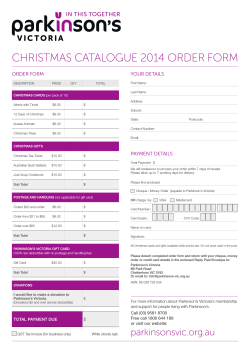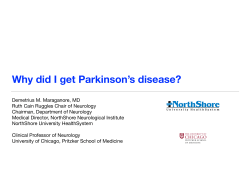
Restoring Movement with Ease
Restoring Movement with Ease TSXV: CTH OTCQX: CYNAF www.cynapsus.ca Cautionary Statements Neither this presentation nor the materials used in this presentations shall constitute an offer to sell or a solicitation of an offer to purchase securities of Cynapsus Therapeutics Inc. (‘Cynapsus”). This presentation contains certain “forward-looking statements” within the meaning of applicable securities laws, which have been prepared by management of Cynapsus without audit or review by independent auditors and is based on management’s judgment of the anticipated set of industry and economic result and conditions and Cynapsus’ intended course of action under those conditions as of the date hereof. Generally, these forward-looking statements can be identified by the use of forward-looking terminology such as “plans”, “expects” or “does not expect”, “is expected”, “budget”, “scheduled”, “estimates”, “forecasts”, “intends”, “anticipates” or “does not anticipate”, or “believes” or variations of such words and phrases or state that certain actions, events or results “may”, “could”, “would”, “might” or “will be taken”, “occur” or “be achieved”. Forward-looking statements are subject to known and unknown risks, uncertainties and other factors that may cause the actual results, level of activity, performance or achievements of Cynapsus to be materially different from those expressed or implied by such forward-looking statements, including but not limited to those risks and uncertainties relating to Cynapsus’ business disclosed under the heading “Risk Factors” in its Annual Information Form dated March 26, 2014 and its other filings with the various Canadian securities regulators which are available online at www.sedar.com. Although Cynapsus has attempted to identify important factors that could cause actual results to differ materially from those contained in forward-looking statements, there may be other factors that cause results not the be as anticipated, estimated or intended. The assumptions used in the preparation of this presentation, although considered reasonable by Cynapsus at the time of preparation, may prove to be incorrect. Recipients are cautioned that the information is based on assumptions as to many factors and that it is likely that actual results will vary significantly from the results projected and such variations may be material. There is no representation by Cynapsus that actual results achieved during the projection period will be the same in whole or in part as those projected. Accordingly, readers should not place undue reliance on such projections or on any forward-looking statements contained herein. Cynapsus does not undertake to update any such projections or forwardlooking statements, except in accordance with applicable securities laws. The information contained herein, while obtained from sources which we believe to be reliable, is not guaranteed as to its accuracy or completeness. Restoring Movement with Ease 2 Highlights Parkinson’s disease “OFF” episodes: significant unmet need Michael J. Fox Foundation Partnership ($1.5M in grants + recruitment access) Issued U.S. Patents and others pending with protection to 2031/33 Human PK Studies (CTH-101, CTH-102, CTH-103, CTH-104) U.S. Phase 2 Clinical Efficacy Study Under FDA IND (CTH-105) Modest resources required to U.S. 505b2 approval ($25M raised in April 2014) Experienced Management Team, Directors and Clinical Advisory Board Only non-injectable delivery of only approved drug for acute rescue of OFF episodes in PD Potential for clinically meaningful differentiation to subcutaneous injection Potential for U.S. NDA approval end of 2016 or early 2017 Restoring Movement with Ease 3 Parkinson’s OFF Episodes and Treatment Restoring Movement with Ease 4 Parkinson’s Disease and OFF Episodes CHRONIC PROGRESSIVE NEURODEGENERATIVE DISEASE Symptoms: Tremor, rigidity, impaired movement Dying cells in movement control Centre of the brain Restoring Movement with Ease US = 1 Million patients WW = 4 to 6 Million patients 2030 = Estimated 2X due to the aging population Approx. 25 to 50% of PD patients experience OFF episodes = impaired movement or speaking 1 to 6 OFF episodes daily in moderate and severe patients Episodes are more frequent over time Episodes are sporadic and limit ability to move and engage in daily life Chronic treatments become less effective over time Dopamine stimulation, replacement or breakdown of inhibitors of dopamine = primary pharmacotherapy patients 5 Types of OFF Episodes OFF episodes are the result of insufficient dopamine in the brain 1. Morning Akinesia 2. 3. Wearing off Sub-therapeutic levels of levodopa prior to next scheduled dose Can be treated by re-arranging dose schedule within limits Unpredictable OFF 4. Despite constant levels of levodopa, consumption of dopamine in the brain varies and depletes dopamine in the brain Latency to ON (dose failure) Lack of dopaminergic drugs overnight results in depleted dopamine reserves in the brain; the most difficult OFF to treat Poor absorption of levodopa results in low brain levels of dopamine Apomorphine rapidly and effectively treats these OFF states Restoring Movement with Ease 6 Apomorphine Apomorphine is currently the only approved drug for the acute management of OFF episodes Apomorphine is the only member of the dopamine agonist class that has rapid onset of activity Apomorphine is currently only available as an injection Restoring Movement with Ease 7 APL-130277 Overview and Expected Attributes APL-130277 is a fast-acting, sublingual, thin filmstrip formulation of apomorphine Designed to manage OFF episodes in Parkinson’s patients To date, studied in approximately 110 patients/subjects in five clinical studies Most recent result is the CTH-105 Phase 2 study Safety/Tolerability/Efficacy Health Economics Minimal irritation Tolerable – few and mild adverse events Appropriate ∆ in UPDRS III & symptomatic relief Potential impact on levodopa use and duration of ON Restoring Movement with Ease Freedom of daily living for patient Ease of opening and administration Possible measurable benefits to the use of other medications and their impact on the patient 8 Top-line Phase 2 Results: CTH-105 Study Reported on November 19, 2014 Restoring Movement with Ease 9 CTH-105 Study Design Study parameters n=16 16 patients have completed the dosing regimen Due to over enrollment of the study, an additional 3 patients are still in dosing (Total n=19) Multicenter open-label study in patients with Parkinson’s disease Subjects required to have a minimum of 2 hours OFF daily Study protocol Patients pre-treated with Tigan® (trimethobenzamide) for 3 days prior to titration and during dosing Levodopa withheld the morning of dosing to induce OFF Escalating doses starting at 10mg up to 30mg, in 5mg increments at a minimum of three hours between doses, based on response (i.e. change in UPDRS part III, clinician observation, patient observation) UPDRS part III was measured at 15, 30, 45, 60 and 90 minutes Effective dose confirmed at a subsequent visit Restoring Movement with Ease 10 Top-line Results – Change in UPDRS III and ON Mean Change in UPDRS Part III from Baseline Over Study Period For Patients Converting from OFF to ON The mean baseline UPDRS III in an OFF state was 41.4 The maximum mean change from baseline UPDRS III was 18.4 The mean dose used to convert patients to ON was 18.4mg The reported mean time to ON was 22 minutes Achieved an approximate 45% improvement in motor function A clinically meaningful improvement in motor control occurred in as early as 10 minutes after administration of APL-130277 and lasted longer than 90 minutes Restoring Movement with Ease 11 Phase 2 Safety Profile 16 patients completed with 60 total doses administered Treatment with APL-130277 was safe and well tolerated There were no serious adverse events Nausea was reported by 3 subjects at doses of 10mg, 15mg and 20mg; there were no reports of nausea at higher doses One of these patients also experienced a mild episode of emesis There were no reports of local irritation or orthostatic hypotension in any subject treated Restoring Movement with Ease 12 Next Steps and Additional Information Restoring Movement with Ease 13 Phase 3 Studies Expected to Begin in 2015 Phase 3 pivotal studies of longer duration and with larger patient numbers to confirm: Efficacy Safety Details of studies to be confirmed with the U.S. Food and Drug Administration (“FDA”) during an End of Phase II meeting These studies will form the registration package necessary for a U.S. 505(b)(2) NDA with the FDA expected to be submitted in 2016 Restoring Movement with Ease 14 Anticipated 505(B)2 “Efficacy” Path to U.S. NDA 2015 2016 CMC Clinical Scale Up and Production (including stability) CTH200 Bridging Study in Healthy Volunteers U.S. FDA Meeting CTH300 Efficacy Study in PD patients CTH301 Pivotal Safety Study in Parkinson’s Patients Restoring Movement with Ease Prepare and File U.S. NDA 15 Commercial Opportunity Market research with physicians, payors, and patients indicate OFF episodes are a significant unmet need Recent Michael J. Fox Foundation Survey found that 90% of Parkinson’s patients suffer OFF episodes and that 65% suffer at least 2 hours OFF daily Academic poster presentation by Rizos et. al. found that 48% of mild Parkinson’s patients, 70% of moderate patients, and 62% of severe patients suffer Early Morning OFF Cynapsus currently estimates APL-130277 may be appropriate treatment for approximately 1 million Parkinson’s patients worldwide: United States = 400,000 European Union (Largest 5 Countries) = 400,000 Rest of World = 200,000 Patients manage one to six OFF episodes per day Anticipated product launch in U.S. in 2017; Europe and Japan in 2018 Restoring Movement with Ease 16 Research Coverage and Share Capital Stock Symbols: TSXV: CTH (Canada); OTCQX: CYNAF (USA) Market Capitalization: ~$90 Million Research Coverage: Noble Life Science Partners, Zacks Small Cap Research, M Partners, SeeThru Equity, Life Science Advisors Share Capital*: Common Shares (Basic) 79,068,867 Warrants 61,300,571 Stock Options TOTAL (Fully Diluted) 4,175,649 144,545,087 *As at November 11, 2014 Restoring Movement with Ease 17 Management Team and Clinical Advisory Board Management Team Clinical Advisory Board Anthony Giovinazzo, President & CEO 20 yrs. CNS-Parkinson’s, Alzheimer’s, Pain, Anxiety, M&A exits Dr. Warren Olanow, MD Henry P. and Georgette Goldschmidt Professor and Chairman of the Department of Neurology at the Mount Sinai School of Medicine in New York City. Internationally recognized expert on movement disorders. Dr. Albert Agro, PhD, Chief Medical Officer 15 yrs. clinical development of CNS & Parkinson’s specifically Dr. Thierry Bilbault, Chief Scientific Officer & EVP CMC 20+ yrs. senior management w/ Global large Pharma, 50+ product launches internationally, 10+ years thin film strip expertise Andrew Williams, Chief Operating/Financial Officer 15 yrs. finance, operations & consulting, 10 yrs. CNS & Parkinson’s Dr. Madhu Hariharan, PhD, Director CMC 18 yrs. drug product expertise and of commercial launches of Rx (NDA, ANDA) thin film drugs, OTC and confectionary products Dr. Judi Weissinger, PhD, Regulatory 20 yrs. regulatory, 10 yrs. at US FDA, Director level Dr. Robin Walker, PhD, Toxicology 20 yrs. toxicology in large Pharma Restoring Movement with Ease Dr. Fabrizio Stocchi, MD, PhD Professor of Neurology and Director of the Parkinson’s Disease and Movement Disorders Research Centre at the Institute for Research and Medical Care, IRCCS San Raffaele, Rome, Italy. Dr. Abraham Lieberman, MD Director of the Muhammad Ali Parkinson Center and the Movement Disorder Clinic of Barrow Neurological Institute at St. Joseph’s Hospital and Medical Center. He is an internationally recognized expert on Parkinson’s disease. Dr. Susan Fox, PhD, CCST Assistant Professor Division of Neurology, Department of Medicine, University of Toronto and University Health Network. Member of largest movement disorders clinic in Canada (Toronto Western). 18 Highlights Parkinson’s disease “OFF” episodes: significant unmet need Michael J. Fox Foundation Partnership ($1.5M in grants + recruitment access) Issued U.S. Patents and others pending with protection to 2031/33 Human PK Studies (CTH-101, CTH-102, CTH-103, CTH-104) U.S. Phase 2 Clinical Efficacy Study Under FDA IND (CTH-105) Modest resources required to U.S. 505b2 approval ($25M raised in April 2014) Experienced Management Team, Directors and Clinical Advisory Board Only non-injectable delivery of only approved drug for acute rescue of OFF episodes in PD Potential for clinically meaningful differentiation to subcutaneous injection Potential for U.S. NDA approval end of 2016 or early 2017 Restoring Movement with Ease 19
© Copyright 2025











